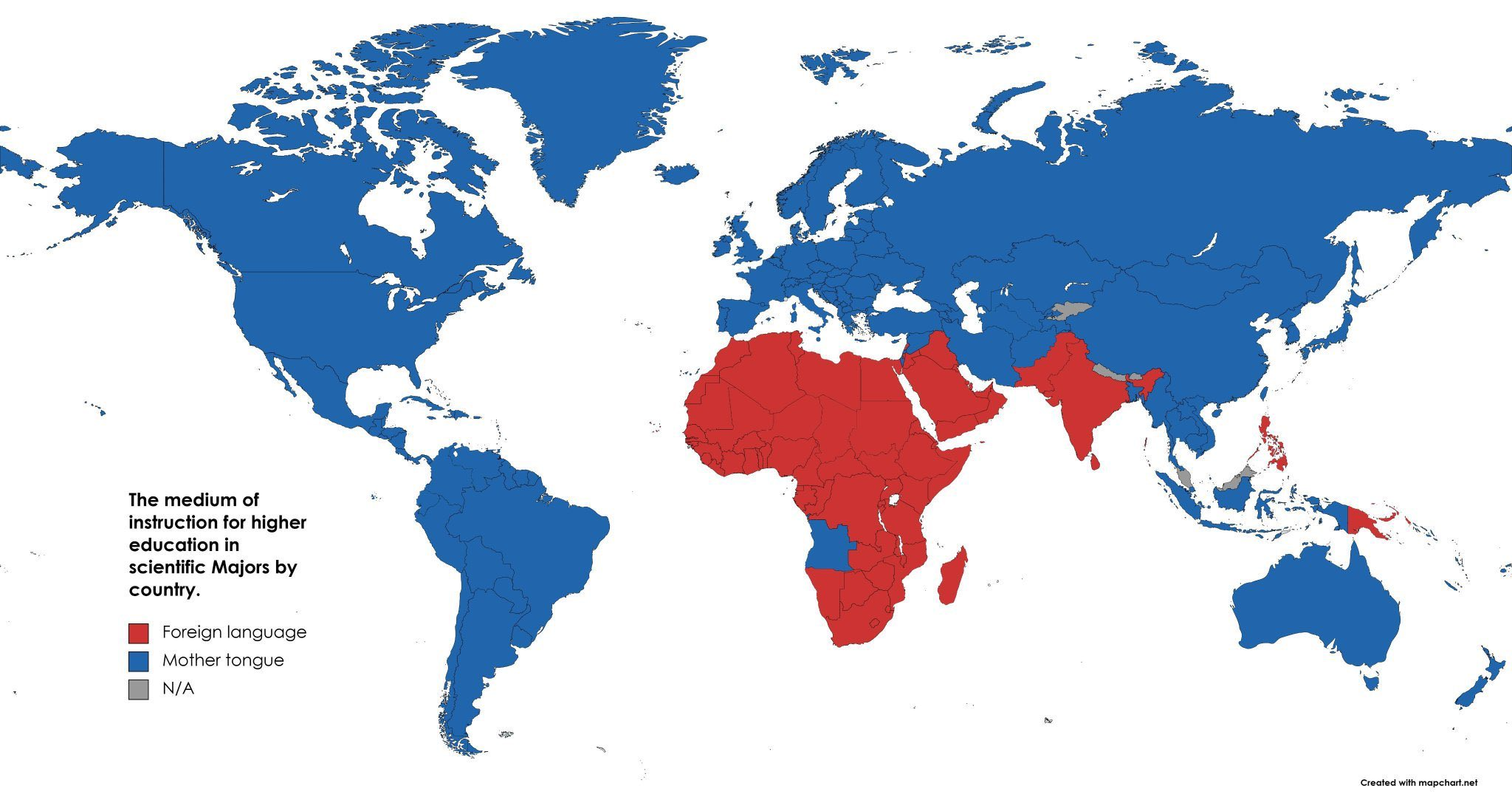Map of Languages Used in Higher Education for Science


Marcus Rodriguez
Historical Geography Expert
Marcus Rodriguez specializes in historical cartography and geographic data analysis. With a background in both history and geography, he brings unique...
Geographic Analysis
What This Map Shows
The map titled "Map showing whether countries use a native or foreign language for higher education in scientific fields" illustrates the linguistic landscape of academia, particularly in the sciences. It highlights which countries prioritize native languages in their educational systems versus those that rely on foreign languages, primarily English, for higher education in fields like engineering, medicine, and natural sciences. This visualization provides a snapshot of how language can shape academic access, research collaboration, and ultimately, scientific innovation.
Deep Dive into Language Use in Higher Education
Language is not just a means of communication; it plays a crucial role in the dissemination of knowledge, especially in scientific fields. In many countries, the medium of instruction can significantly affect students' educational experiences and outcomes. For instance, in nations like Germany and France, higher education institutions predominantly use their native languages, which can enhance understanding and engagement for local students. However, this may also limit the accessibility of these programs to international students who do not speak the language fluently.
Conversely, English has become the lingua franca of science and technology. Countries like the Netherlands and Sweden have adopted English as the primary language for higher education in scientific disciplines, making their universities more attractive to global talent. This shift reflects a broader trend where English proficiency is increasingly seen as essential for scientific collaboration and competitiveness in the global arena. Interestingly, according to a report by the European Commission, around 80% of master's programs in the Netherlands are taught in English, which has significantly boosted international student enrollment.
What's fascinating is that the choice of language in higher education often mirrors a country's historical and cultural ties. For instance, former colonies may retain colonial languages in their educational systems. In countries like India and Nigeria, English remains a dominant language of instruction, often even in local scientific institutions, reflecting their colonial past. On the other hand, countries with strong linguistic identities, such as Japan or China, often emphasize native languages, which can foster a sense of national pride but may also limit the global reach of their research.
Moreover, the language used in higher education is closely linked to research output and scientific innovation. Research has shown that countries that offer programs in English tend to produce more internationally recognized research publications. This is likely due to the enhanced collaboration opportunities and access to a wider pool of academic resources available in English. In contrast, countries that rely heavily on native languages may face challenges in gaining visibility on the global stage, affecting their ability to attract international researchers and funding.
Regional Analysis
When examining regions, significant variations emerge in language use for higher education. In Europe, for instance, there's a noticeable divide. Northern European countries like Finland and Denmark primarily use English, whereas Southern European countries, such as Italy and Spain, still maintain a strong emphasis on their native languages for academic instruction. This divergence can be attributed to varying educational policies and cultural attitudes towards language and education.
In Asia, the situation is equally diverse. Countries like Singapore and Malaysia offer a blend of English and native languages, reflecting their multicultural societies. In contrast, Japan and South Korea predominantly use their native languages, albeit with increasing English integration in higher education, particularly in graduate programs. Interestingly, countries in the Middle East exhibit a mix as well; for example, the UAE has embraced English in higher education to attract international students and research partnerships, while others maintain Arabic as the primary language.
Africa presents a complex picture. Many nations utilize colonial languages, such as English and French, for higher education, which can create barriers for local students who may not be proficient. However, there’s a growing movement in various countries to promote native languages in academia to preserve cultural heritage and improve educational access.
Significance and Impact
Understanding the linguistic dynamics in higher education is crucial for several reasons. It not only affects student access and success but also has broader implications for national development and global collaboration. Countries that effectively incorporate English into their educational systems often see a rise in international collaborations, research funding, and technological advancements. Conversely, nations that do not adapt may find themselves isolated in the global scientific community.
Moreover, as the world becomes increasingly interconnected, the demand for multilingual professionals is on the rise. Students who are educated in English may have better job prospects in multinational companies and international organizations. This trend underscores the importance of language policy in shaping the future workforce and ensuring that countries remain competitive on the global stage.
In conclusion, the map serves as a valuable tool to understand the intricate relationship between language and higher education in scientific fields. It reveals the diverse approaches countries take in balancing cultural identity with the need for global collaboration. As we move forward, the decisions made about language in education will undoubtedly continue to influence scientific progress and international partnerships, shaping the future of research and innovation around the world.
Visualization Details
- Published
- October 12, 2025
- Views
- 52
Comments
Loading comments...